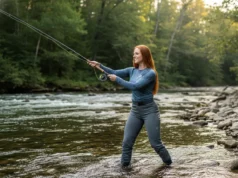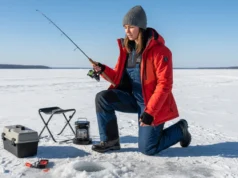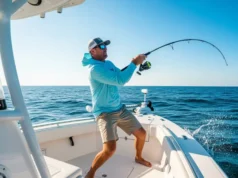In this article
Walking into a tackle shop for the first time can feel like deciphering a foreign language. Rows of spinning rods, all seemingly identical yet covered in cryptic labels like “7’0″ M Fast” and “I-M8 Graphite,” can make you want to turn around and leave. But the right spinning rod isn’t just a tool; it’s your direct line to the underwater world and the key to turning a frustrating day into a memorable one. This guide is designed to cut through that noise, teach you the language of fishing rods, and lead you directly to the perfect beginner fishing rod for your 2025 recreational fishing adventures, whether you’re targeting bass, panfish, or trout.
Before we dive in, know that our path is clear. We’ll first break down the “Big Four” terms on any fishing rod—rod length, rod power, rod action, and blank material—and explain exactly what they mean for your performance on the water. You’ll then meet our top rod options, tailored for three distinct types of anglers: “The Cautious Novice,” “The All-Around Aspirant,” and “The Future Finesse Specialist.” We’ll show you exactly how we analyzed expert reviews, user feedback, and manufacturer data to make our selections, ensuring our process is completely transparent. With this knowledge, you can skip the guesswork and choose a rod that fits your budget, fishing style, and durability needs from day one.
How to Choose the Right Spinning Rod: An Expert’s Framework
Our mission here is to arm you with the objective knowledge needed for how-to choose a smart, confident option. We’re moving beyond simple definitions to explain the direct consequences of each design choice, so you understand not just what a spec means, but why it matters for the species and techniques you’re interested in, from freshwater to light inshore applications.
Why Does Rod Length Matter?
The first decision you’ll face is rod length, a fundamental choice that creates a core trade-off between casting distance and casting accuracy. Longer rods, those measuring seven feet or more, create a wider casting arc. This generates more tip speed and acts like a longer lever, allowing you to launch lures farther out into the water with long casts. This is a major advantage for anyone fishing from the bank of a large pond or covering wide, open-water flats where fish like walleye or stripers might be scattered.
On the other hand, shorter rods, typically under six and a half feet, are far more maneuverable. They offer superior precision for placing a lure in tight quarters. If you’re skipping docks with a bait, navigating a narrow creek for trout, or trying to make a delicate cast around pilings, a shorter rod gives you the control you need to avoid snags. For a novice angler, the sweet spot that balances these two attributes is a length between 6’6″ and 7’0″. This range offers the best all-around versatility, providing enough distance for most freshwater scenarios without sacrificing the accuracy needed as you build your skills.
Pro-Tip: When you’re in a shop, stand a 7’0″ rod on its butt end. The tip will likely be just above your head. This gives you a physical sense of how much room you’ll need around you to cast effectively. If you fish in tight, overgrown areas, a shorter 6’6″ rod might feel much more comfortable.
Now that you know how far you can cast, let’s talk about what you can cast.
What is the Difference Between Rod “Power” and “Action”?
Rod Power and Rod Action are the two most misunderstood terms in fishing, but they work together to define a rod’s personality. Think of Power as the rod’s strength or “backbone.” It describes how much pressure it takes to bend the rod and is rated on a scale from Ultra-Light to Medium, Medium-Heavy, and Extra-Heavy. Power dictates the rod’s lifting strength and, crucially, determines the appropriate lure weight rating and line rating. An Ultra-Light power rod is designed for tiny lures and thin line for panfish, while an Extra-Heavy power rod is built to winch big bass out of thick cover with heavy braided line.
Action, conversely, describes the flex point—or where the rod bends along its blank. A Fast action rod bends mostly in the top third, creating a crisp, sensitive feel that’s excellent for transmitting vibrations and enabling quick, powerful hooksets for finesse techniques. A Moderate action or Slow action rod bends deeper into its middle or lower third. This slower, more parabolic bend acts as a shock absorber, which is perfect for keeping fish pinned on a crankbait with small treble hooks, as it prevents you from ripping them out during a fight.
These two specs are critically paired. A “Medium Power / Fast Action” rod is the classic, versatile workhorse for an entry-level angler, ideal for single-hook lures like plastic worms and jigs used in dropshot or shaky head applications. The Medium Power provides enough backbone for a solid hookset on a bass, and the Fast Action provides the sensitivity to feel a subtle bite. For treble-hooked lures like a small swimbait, a “Medium Power / Moderate Action” rod would be better, as the forgiving action keeps those small hooks from tearing free. You can learn more from this excellent resource on the topic: Kentucky Afield Outdoors — Power vs-Action.
The material a rod is made from is the foundation for both its power and action.
Does Blank Material Really Make a Difference?
Absolutely. The blank material of the rod dictates its sensitivity, durability, and weight. Graphite, especially high-modulus carbon like SCIII Graphite, is the modern standard for performance. It’s exceptionally lightweight and stiff, which allows it to transmit vibrations from the lure to your hand with incredible clarity. This sensitivity lets you feel subtle bites, differentiate between a rock and a log on the bottom, and ultimately connect with more fish. The trade-off is that high-performance graphite can be more brittle and less forgiving of accidental abuse, like getting slammed in a car door.
Fiberglass, on the other hand, is known for its extreme durability and lower cost. It’s heavier and much more flexible than graphite, giving it a slower action. This makes it a very forgiving choice for beginners, as it can withstand bumps and drops that might snap a graphite rod. However, its flexibility dampens vibrations, making it a poor choice for technique-specific applications that require you to feel what your lure is doing.
This leads us to the ideal material for many beginner rods: a Composite, or Graphite/Fiberglass blend. These composite rods aim to provide the best of both worlds. A graphite inner core reduces weight and increases sensitivity, while a protective fiberglass outer layer provides the legendary durability needed to survive the learning process. It’s the perfect middle ground as you build your skills, often paired with comfortable grip material like a cork handle or EVA grip.
Pro-Tip: To quickly test a rod’s sensitivity in the store, have a friend hold the very tip of the rod while you hold the handle in a fishing grip. Close your eyes and ask them to tap their fingernail lightly on the rod blank. On a sensitive graphite or composite rod, you’ll feel that “tick” transfer all the way down to your hand.
| Feature | Graphite | Composite | Fiberglass |
|---|---|---|---|
| Sensitivity | High. Exceptionally lightweight and stiff, it transmits vibrations with incredible clarity. | Medium. The graphite core provides good sensitivity, but the fiberglass outer layer dampens it slightly. | Low. Its high flexibility and density dampen vibrations, making it difficult to feel subtle bites. |
| Durability | Low. It can be brittle and prone to snapping under stress or from accidental impact. | High. The protective fiberglass outer layer makes it very forgiving and resistant to bumps and drops. | Very High. Known for its extreme durability and ability to withstand significant abuse without breaking. |
| Weight | Low. The modern standard for a lightweight and easy-to-handle rod. | Medium. Lighter than pure fiberglass but noticeably heavier than high-modulus graphite. | High. The heaviest of the three materials, which can lead to fatigue over long fishing sessions. |
| Cost | Medium to High. Varies based on the quality and modulus of the carbon fiber used. | Low to Medium. Offers a great balance of performance and durability at an affordable price point. | Low. Generally the most affordable option, making it a great entry point for beginners. |
With this foundational knowledge, you can now appreciate how we evaluated the top rods on the market.
Our Selection Process: How We Built This Guide
To build a guide you can truly trust, we want to be completely transparent about our rigorous research and curation process. Our commitment is to objectivity; this guide is not based on our personal opinions alone. We’ve created a systematic framework to provide you with objective, data-driven recommendations. Our goal is to empower you, not just sell you a product.
Our evaluation framework began by defining five critical scoring criteria for a beginner fishing rod: Versatility (how many techniques and freshwater species can it handle?), Durability & Forgiveness (can it withstand mistakes?), Sensitivity (how well does it transmit bites?), Ergonomics & Balance (is the handle comfortable to fish all day?), and Overall Value (does its performance and warranty justify its price band?).
With this framework in place, our selection process had two phases. First, we synthesized data from dozens of expert reviews, forum discussions, and aggregated user feedback to score 12 top contenders against our criteria. Second, we segmented the beginner audience into the three distinct personas you’ll meet below. This allowed us to curate the top-scoring, most appropriate products for each specific need, ensuring our recommendations are not just good, but good for you, whether you need a standalone rod or a full combo kit.
A quick note on affiliate links: If you choose to purchase a product through one of our links, we may earn a small commission at no extra cost to you. This helps support our work in creating in-depth, unbiased guides like this one. We only recommend products that have met our rigorous evaluation criteria.
The Best Spinning Rods of 2025: Our Top Recommendations for Every Need
Our curated recommendations are designed to match the key user personas we identified, ensuring every angler finds a perfect match for their specific goals and budget.
Our Top Picks for “The Cautious Novice”
This angler prioritizes durability and value above all else. They are new to the sport, likely on a tight budget, and need gear that can withstand the inevitable mistakes of the learning process—from accidental drops on the boat ramp to snagging a tree on a backcast. These rods are built to be tough, forgiving, and incredibly reliable, perfect for a first rod you won’t outgrow too quickly.
Our Top Picks for “The All-Around Aspirant”
This intermediate angler has some experience and is ready for a considered purchase. They value a significant performance upgrade in versatility and sensitivity. They are willing to invest in a quality spinning rod and reel combo they won’t outgrow in a single season, looking for a balanced combo that feels good in the hand and excels at a variety of techniques for species like bass, trout, and walleye.
Our Top Picks for “The Future Finesse Specialist”
This dedicated learner is already researching advanced, technique-specific applications. They prioritize maximum sensitivity and refined ergonomics to emulate the pros and are willing to invest in a “serious” high-modulus graphite rod designed for light-line, technical presentations. They understand that feeling the lightest bite during a dropshot or shaky head retrieve is the key to success and need a quality rod with a good warranty.
Conclusion
Choosing your first spinning rod is a rite of passage, and the right choice sets the stage for years of enjoyment on the water. Remember that the best all-around spinning rod for a beginner is typically 6’6″ to 7’0″ long with a Medium or Medium-Light power and a Fast or Moderate-Fast action. The blank material dictates the fundamental trade-off between the durability of fiberglass or composites and the sensitivity of graphite. Instead of looking at individual specs in isolation, always evaluate the “pairing” of power and action to understand a rod’s intended purpose. Ultimately, choosing the right rod starts with an honest assessment of your budget, your primary fishing environment, and how much you value high performance versus near-indestructibility.
Now that you’re equipped with the knowledge to choose confidently, which rod are you leaning towards? Let us know in the comments below, and don’t forget to share this guide with a friend who’s just starting their fishing journey!
Frequently Asked Questions about Beginner Spinning Rods
What is the best rod length for a beginner?
For maximum versatility, a beginner should choose a rod between 6 feet 6 inches and 7 feet long. This range provides a great compromise between casting distance and accuracy, making it suitable for ponds, lakes, and rivers. A rod in this length is long enough to make effective casts from the bank but short enough to remain manageable in tighter spots. The Pflueger President Spinning Combo is an excellent example that comes in this ideal length.
What’s the real difference between rod power and action?
Simply put, power is the rod’s strength (how much it takes to bend it), while action is where the rod bends. Think of it this way: a “Medium Power” rod has the backbone needed to fight average-sized bass, providing enough strength to control the fish. A “Fast Action” means the rod bends primarily near the tip, which makes it very sensitive for feeling bites and allows for a quick, snappy hookset. Our educational section above has a diagram that explains this visually.
Should a beginner buy a combo or a separate rod and reel?
For most beginners, especially those on a budget, a pre-matched reel combo is the ideal choice as it eliminates the guesswork of pairing components. Manufacturers design spinning combos to be balanced and work well together right out of the package. The Ugly Stik GX2 Combo is a fantastic, budget-friendly option that comes ready to fish. Anglers who want higher performance from the start might consider buying a standalone rod like the Fenwick Eagle to pair with a quality spinning reel of their choice, which allows for more customization.
Is a graphite or fiberglass rod better for a beginner?
It depends entirely on your priority. A composite or fiberglass rod like the Ugly Stik Elite is better if you prioritize extreme durability. It can handle being knocked around in a truck bed or dropped on rocks. A graphite rod like the one in the Pflueger President combo is better if you want more sensitivity to feel subtle bites. For most novices, composite rods that blend both materials offer the best of both worlds: a forgiving yet sensitive starting point.
Risk Disclaimer: Fishing, boating, and all related outdoor activities involve inherent risks that can lead to injury. The information provided on Master Fishing Mag is for educational and informational purposes only. While we strive for accuracy, the information, techniques, and advice on gear and safety are not a substitute for your own best judgment, local knowledge, and adherence to official regulations. Fishing regulations, including seasons, size limits, and species restrictions, change frequently and vary by location. Always consult the latest official regulations from your local fish and wildlife agency before heading out. Proper handling of hooks, knives, and other sharp equipment is essential for safety. Furthermore, be aware of local fish consumption advisories. By using this website, you agree that you are solely responsible for your own safety and for complying with all applicable laws. Any reliance you place on our content is strictly at your own risk. Master Fishing Mag and its authors will not be held liable for any injury, damage, or loss sustained in connection with the use of the information herein.
Affiliate Disclosure: We are a participant in the Amazon Services LLC Associates Program, an affiliate advertising program designed to provide a means for us to earn advertising fees by advertising and linking to Amazon.com. As an Amazon Associate, we earn from qualifying purchases. We also participate in other affiliate programs and may receive a commission on products purchased through our links, at no extra cost to you. Additional terms are found in the terms of service.





